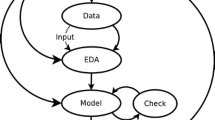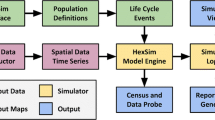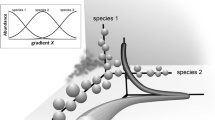Abstract
Simulated data, derived from descriptive models of community variation along ecological gradients, are useful for the evaluation of ordination techniques and other numerical methods for the analysis of community data. Existing approaches to the simulation of community patterns are based on restrictive assumptions, although there is evidence supporting several alternative models. Simulation studies should aim to assess the robustness of analytical techniques to variations in model properties. This paper describes a modelling procedure which encompasses most current concepts and hypotheses about the properties of community patterns. The procedure has been used to assess the comparative robustness of several ordination techniques and to examine the effectiveness of alternative coefficients of compositional dissimilarity. COMPAS, a FORTRAN 77 computer program which implements the modelling procedure, is available on application to the author.
Similar content being viewed by others
References
Austin M. P. 1976. On non-linear species response models in ordination. Vegetatio 33: 33–41.
Austin M. P. 1980. Searching for a model for use in vegetation analysis. Vegetatio 42: 11–21.
Austin M. P. 1981. The role of certain diversity properties in vegetation classification. In: A. N. Gillison & D. J. Anderson (eds), Vegetation classification in Australia, pp. 125–140. A. N. U. Press, Canberra.
Austin M. P. 1985. Continuum concept, ordination methods and niche theory. Ann. Rev. Ecol. Syst. 16: 39–61.
Austin M. P. 1987. Models for the analysis of species' response to environmental gradients. Vegetatio 69: 35–45.
Austin M. P. & Austin B. O. 1980. Behaviour of experimental plant communities along a nutrient gradient. J. Ecol. 68: 891–918.
Austin M. P. & Cunningham R. B. 1981. Observational analysis of environmental gradients. Proc. Ecol. Soc. Aust. 11: 109–119.
Austin M. P. Cunningham R. B. & Fleming P. M. 1984. New approaches to direct gradient analysis using environmental scalars and statistical curve-fitting procedures. Vegetatio 55: 11–27.
Austin M. P. Cunningham R. B. & Good R. B. 1983. Altitudinal distribution of several eucalypt species in relation to other environmental factors in southern New South Wales. Aust. J. Ecol. 8: 169–180.
Ellenberg H. 1953. Physiologisches und ökologisches Verhalten derselben Pflanzenarten. Ber. Deutsch. Bot. Ges. 65: 350–361.
Ellenberg H. 1954. Über einige Fortschritte der kausalen Vegetationskunde. Vegetatio 5/6: 199–211.
Faith D. P. Minchin P. R. & Belbin L. 1987. Compositional dissimilarity as a robust measure of ecological distance. Vegetatio 69: 57–68.
Fresco L. F. M. 1982. An analysis of species response curves and of competition from field data: some results from heath vegetation. Vegetatio 48: 175–185.
Gauch H. G. 1982. Noise reduction by eigenvector ordinations. Ecology 63: 1643–1649.
Gauch H. G. Chase G. B. & Whittaker R. H. 1974. Ordination of vegetation samples by Gaussian species distributions. Ecology 55: 1382–1390.
Gauch H. G. & Whittaker R. H. 1972. Coenocline simulation. Ecology 53: 446–451.
Gauch H. G. & Whittaker R. H. 1976. Simulation of community patterns. Vegetatio 33: 13–16.
Gauch H. G. & Whittaker R. H. 1981. Hierarchical classification of community data. J. Ecol. 69: 537–557.
Gauch H. G. Whittaker R. H. & Singer S. B. 1981. A comparative study of nonmetric ordinations. J. Ecol. 69: 135–152.
Greig-Smith P. 1980. The development of numerical classification and ordination. Vegetatio 42: 1–9.
Grime J. P. 1973. Control of species density in herbaceous vegetation. J. Environ. Manage. 1: 151–167.
Hill M. O. & Gauch H. G. 1980. Detrended correspondence analysis, an improved ordination technique. Vegetatio 42: 47–58.
Kenkel N. C. & Orlóci L. 1986. Applying metric and nonmetric multidimensional scaling to ecological studies: some new results. Ecology 67: 919–928.
Lagonegro M. 1984. Spaghet: a coenocline simulator useful to calibrate software detectors. Stud. Geobot. 4: 63–99.
Margules C. R. Nicholls A. O. & Austin M. P. 1987. Diversity of Eucalyptus species predicted by a multi-variable environmental gradient. Oecologia 71: 229–232.
Minchin, P. R. 1983. A comparative evaluation of techniques for ecological ordination using simulated vegetation data and an integrated ordination-classification analysis of the alpine and subalpine plant communities of the Mt Field plateau, Tasmania, Ph.D. thesis, University of Tasmania.
Minchin P. R. 1987. An evaluation of the relative robustness of techniques for ecological ordination. Vegetatio 69: 89–107.
Mohler C. L. 1981. Effects of sample distribution along gradients on eigenvector ordination. Vegetatio 45: 141–145.
Mueller-Dombois D. & Ellenberg H. 1974. Aims and methods of vegetation ecology. John Wiley & Sons, New York.
Mueller-Dombois D. & Sims H. P. 1966. Response of three grasses to two soils and a water table depth gradient. Ecology 47: 644–648.
Okland R. H. 1986. Rescaling of ecological gradients. I. The effect of scale on symmetry of species response curves. Nord. J. Bot. 6: 661–669.
Peet R. K. 1978. Forest vegetation of the Colorado Front Range: patterns of species diversity. Vegetatio 37: 65–78.
Prentice I. C. 1980. Vegetation analysis and order invariant gradient models. Vegetatio 42: 27–34.
Swan J. M. A. 1970. An examination of some ordination problems by use of simulated vegetational data. Ecology 51: 89–102.
Werger M. J. A. Louppen J. M. W. & Eppink J. H. M. 1983. Species performance and vegetation boundaries along an environmental gradient. Vegetatio 52: 141–150.
Westman W. E. 1980. Gaussian analysis: identifying environmental factors influencing bell-shaped species distributions. Ecology 61: 733–739.
Whittaker R. H. 1956. Vegetation of the Great Smoky Mountains. Ecol. Monogr. 26: 1–80.
Whittaker R. H. 1960. Vegetation of the Siskiyou Mountains, Oregon and California. Ecol. Monogr. 30: 279–338.
Whittaker R. H. 1967. Gradient analysis of vegetation. Biol. Rev. 42: 207–264.
Whittaker R. H. 1970. Communities and ecosystems. 1st ed. Macmillan, London.
Whittaker R. H. & Gauch H. G. 1978. Evaluation of ordination techniques. In: R. H. Whittaker (ed.), Ordination of plant communities, pp. 227–336. Junk, The Hague.
Whittaker R. H. & Niering W. A. 1965. Vegetation of the Santa Catalina Mountains, Arizona. II. A gradient analysis of the South slope. Ecology 46: 429–452.
Whittaker R. H. & Niering W. A. 1975. Vegetation of the Santa Catalina Mountains, Arizona. V. Biomass, production and diversity along the elevation gradient. Ecology 56: 771–790.
Wilson M. V. & Mohler C. L. 1983. Measuring compositional change along gradients. Vegetatio 54: 129–141.
Author information
Authors and Affiliations
Rights and permissions
About this article
Cite this article
Minchin, P.R. Simulation of multidimensional community patterns: towards a comprehensive model. Vegetatio 71, 145–156 (1987). https://doi.org/10.1007/BF00039167
Received:
Issue Date:
DOI: https://doi.org/10.1007/BF00039167




